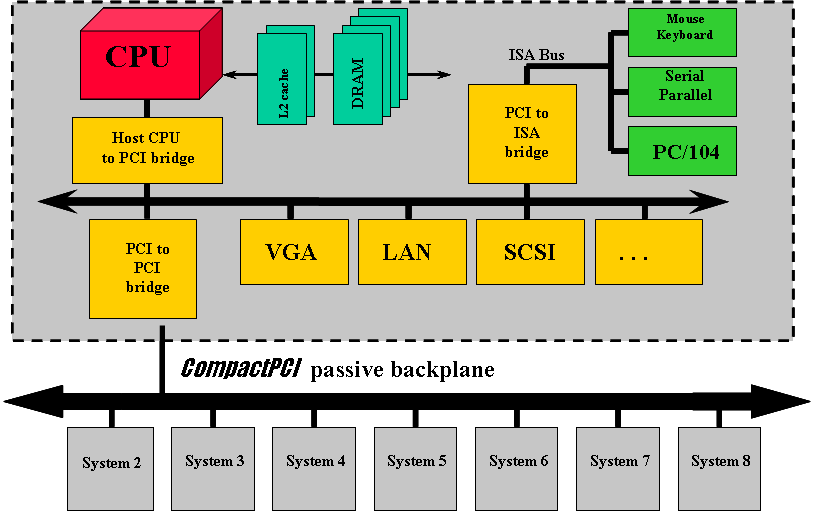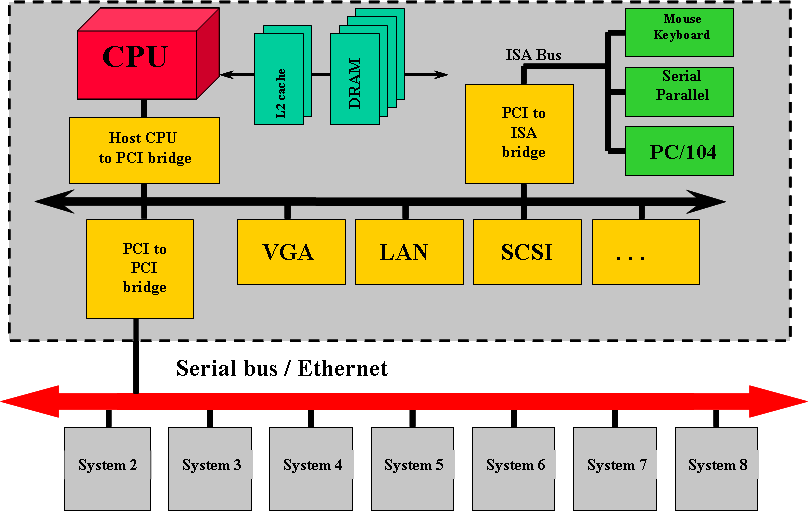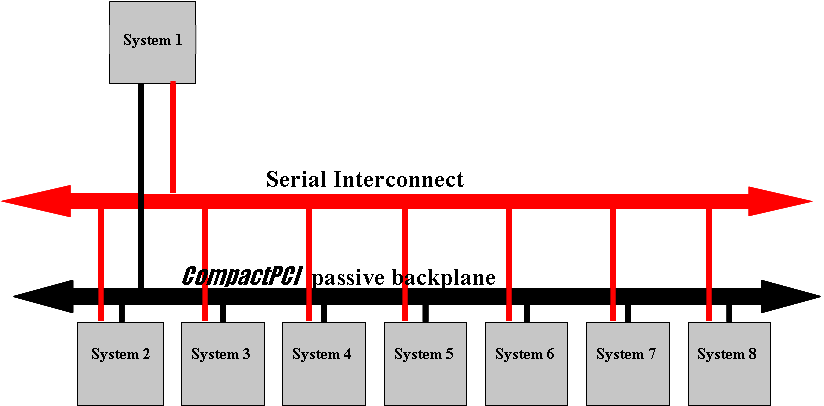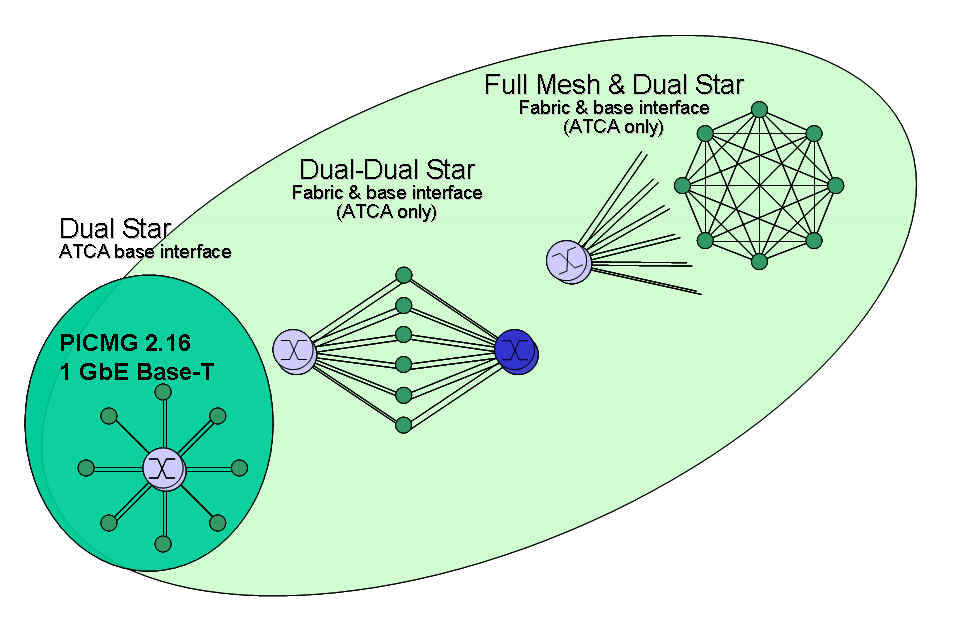
Overview and introduction available specification sets
The specifications provided by PICMG Europe can be divided in 3 series and a group of related specifications.
Series 1 - Passive Backplane specifications;
Series 2 - CompactPCI specifications;
Series 3 - Advanced Telecommunication Computer Architecture, AdvancedTCA, or ATCA;
Other Specifications.
In order to understand these different sets, a little historical overview can help.
The first computer bus systems are available
since the 70's. These busses connected different functions, like CPU, memory,
and serial interfaces. For this reason it had (often) parallel channels for data
and addresses, sometimes multiplexed together. The ISA bus, and passive backplanes
based on this, as well as the CompactPCI bus are excellent examples of this.
If we would build a PC-like functionality at that time, it would look like this:

Due to the higher level of integration, the whole functionality / system as shown above would fit on one module only. With this, the computer bus, like CompactPCI became a system to system interface:

Alternatively, we all know a different system interconnect from the office environment: a serial bus like Ethernet:

One can combine both into one system. This is done in the CompactPCI series 2.16, 2.17 and 2.18, supporting both a parallel bus as well as multiple serial busses. Networks can include: Ethernet, Fibre Channel, InfiniBand, StarFabric, PCI-Express and Advanced Switching, and RapidIO. For instance, CompactPCI 2.16 is based on Gigabit Ethernet.

If we take out the parallel bus in the example above, and work with just multiple serial busses, we are at the level of AdvancedTCA. With this, the Single Board Computers, SBCs, are known as 'Blades' to reflect this. Often they include multiple DSP modules on a board, or multiple CPU. Also here, the networks can include: Ethernet, Fibre Channel, InfiniBand, StarFabric, PCI-Express and Advanced Switching, and RapidIO.
With serial busses, several topologies can exist, connecting the intelligent modules in different ways:

The backplanes can support multiple versions of this, like shown for AdvancedTCA, ATCA, here above.
The move to serial busses, or packet switching, comes from the need for high availability systems, with an uptime till 99,999%. This high level of availability asks for redundant systems. Redundant systems can be easier built and maintained with serial busses. CompactPCI is parallel bus. AdvancedTCA is serial bus. CompactPCI 2.16 combines both.
Advanced Telecommunication Computer Architecture, AdvancedTCA, or ATCA, is, like its name says, targeted at a different world than CompactPCI - the core of the telecommunication world. For this, it has quite different properties than CompactPCI. Two major comparisons are shown here:
|
CompactPCI |
AdvancedTCA |
|
|
|
| Board size: 6U x 160 mm |
8U x 280 mm |
| Distance between modules: 0.8 board pitch |
1.2 board pitch |
| Board area: 367 cm² |
903 cm² board area |
| Power consumption per module: 35 - 50 W |
150 - 200 W |
Comparison
of CPCI, CPCI 2.16, and ATCA
|
Attribute |
PICMG2 / CPCI |
PICMG2.16 / CPSB |
PICMG3 / ATCA |
|
Board Size |
6U
x 160mm x .8 57 sq in + 2 Mez |
6U
x 160mm x .8 57
sq in + 2 Mez |
8U*
x 280mm x 1.2 140
sq in +4 Mez |
|
Board Power |
35-50W |
35-50W |
150-200W |
|
Backplane Bandwidth |
~4Gb/s |
~38Gb/s |
~2.4Tb/s |
|
# Active Boards |
21 |
19 |
16 |
|
Power System |
Centralized Converter 5, 12, 3.3V Backplane |
Centralized Converter 5, 12, 3.3V Backplane |
Distributed Converters Dual 48V Backplane |
|
Management |
OK |
OK |
Advanced |
|
I/O |
Limited |
OK |
Extensive |
|
Clock, update, test bus |
No |
No |
Yes |
|
Multi-vendor
support |
Extensive |
Building |
Since end 2003 |
|
Base cost of shelf |
Low |
Low - Moderate |
Moderate-High |
|
Regulatory conformance |
Vendor specific |
Vendor specific |
In standard |
|
Functional density of shelf |
Low |
Moderate |
High |
|
Lifecycle cost per function |
High |
Moderate |
Low |
|
Standard GA Schedule |
1995 |
2001 |
2H2003 |
PICMG is
committed to open specifications, developed by member companies who
represent a broad cross section of the industrial marketplace and available to
all.
Specifications are developed by technical committees composed of representatives
of a group of member companies, placed in the public domain after a vote by all
Executive members, and then maintained by PICMG.
Click here for a complete status of PICMG specifications, both published and under development.
Click here to view list of short forms of PICMG specifications.
Specifications developed include:
Passive
Backplane PCI-ISA (PICMG 1.x series) defines backplane and connector standards for plug-in
passive backplane CPU boards (sometimes called slot cards) that bridge to
both PCI and ISA busses. The specifications include the base sep, as well as
PCI bridging.
CompactPCI
(PICMG 2.x series) is a specification for PCI-based industrial computers that combines the
power of low cost PCI silicon and software with the rugged Eurocard
packaging popularized by the VMEbus. Revision 3.0 of the CompactPCI Core
Specification incorporates features from PICMG's Hot Swap and Computer
Telephony specifications, such as pin sequencing. It also adds 66 MHz
operation with up to five peripheral slots, support for Hot Swap at 3.3 volt
signaling levels, and a reservation of pins for system management functions.
The set of specifications include Keying, Power interface, User defined I/O
pin assignments, Hot swap and software support for this, and Computer
Telephony specification.
The logical next step is CompactPCI
Express, with the base standard EXP.0. The move from CompactPCI to
CompactPCI Express includes the influence from the Telecom Equipment
Manufacturers with high availability architectures up to 99.999%, which need
additional items like hotswap and system management.
Within a CompactPCI system the serial point-to-point connections are
realized in a proprietary way via user-defined pins on the J2 connector.
Unfortunately, this leads to a growing incompatibility of assemblies from
different manufacturers. Therefore, two new PICMG standards -
CompactPCI PlusIO (PICMG 2.30) and
CompactPCI Serial (PICMG CPCI-S.0) -
define the common integration of serial high-speed signals into a modular
19" environment.
With AdvancedTCA, most of the specification
is done in PICMG 3.0, the base specification. This includes Power
Distribution, Mechanical Elements, System management, Connector zones and
types, Fabric topologies, thermal management guidelines, and Regulatory
Guidelines.
The other specifications in this series define different
serial communication networks, like Ethernet and Fibre
Channel, InfiniBand, StarFabric, PCI-Express and Advanced Switching, and
RapidIO..
Other specifications include Advanced Mezzanine Card architecture,
MicroTCA and COM
Express.
PICMG Master Glossary
The PICMG
Master Glossary contains a compilation of the definitions used in PICMG
specifications
In February 2007 the ASI SIG disbanded and transferred its specifications and documenation to PICMG so that they continue to be available. There are five specifications developed by the ASI SIG that are now available the same way as PICMG specifications are.